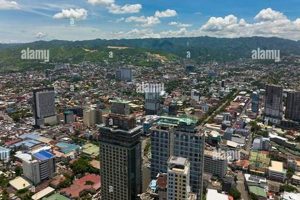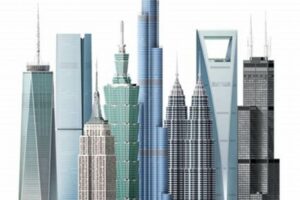A skyscraper is a continuously habitable high-rise building that has over 40 floors and is taller than 150 meters or 492 feet. The term skyscraper was first used in the late 19th century to describe the tall buildings that were being constructed in Chicago at the time. Today, skyscrapers are found in cities all over the world and are used for a variety of purposes, including residential, commercial, and mixed-use.
Skyscrapers offer a number of advantages over other types of buildings. They can accommodate a large number of people in a relatively small amount of space, which makes them ideal for dense urban areas. Skyscrapers are also energy-efficient, as they can be designed to take advantage of natural light and ventilation. In addition, skyscrapers can be iconic landmarks that help to define a city’s skyline.
The construction of skyscrapers has been made possible by a number of technological advances, including the development of steel-frame construction and the invention of the elevator. The first skyscraper was the Home Insurance Building in Chicago, which was completed in 1885. Since then, skyscrapers have become increasingly tall and complex, with some of the tallest buildings in the world now reaching over 1,000 feet in height.
1. Height
The towering height of skyscrapers, reaching beyond 150 meters, is a defining characteristic that sets them apart from other buildings. This vertical dominance has a profound impact on the urban landscape and the experience of those who inhabit these structures.
- Verticality and Urban Density: Skyscrapers maximize land use in densely populated urban areas, accommodating a significant number of people within a compact footprint. This vertical orientation reduces urban sprawl and promotes efficient land management.
- Panoramic Views and Natural Light: The elevated height of skyscrapers offers breathtaking panoramic views of the surrounding cityscape and natural environment. Floor-to-ceiling windows and balconies allow for ample natural light to penetrate the building, reducing the need for artificial lighting and promoting a healthier indoor environment.
- Architectural Innovation: Constructing skyscrapers requires innovative engineering solutions to overcome challenges posed by height and wind resistance. These structures often incorporate advanced materials, such as steel and glass, and employ sophisticated structural systems to ensure stability and safety.
- Symbolic and Cultural Significance: Skyscrapers have become iconic symbols of cities and nations, representing economic power, technological advancement, and architectural ambition. They serve as landmarks that shape the identity and character of urban environments and inspire awe and admiration.
In conclusion, the height of skyscrapers is not merely a physical attribute but a multifaceted aspect that influences urban planning, architectural design, and the overall experience of these towering structures. Their vertical presence contributes to efficient land use, provides unparalleled views, showcases architectural ingenuity, and embodies the cultural and economic aspirations of cities worldwide.
2. Floors
The multitude of floors in a skyscraper, typically exceeding 40, is a crucial aspect that distinguishes it from other buildings and contributes to its unique characteristics and functionality.
The abundance of floors in a skyscraper serves several key purposes:
- Vertical Space Utilization: Skyscrapers maximize vertical space by stacking numerous floors, allowing for efficient land use in densely populated urban areas. This vertical orientation enables the accommodation of a large number of occupants within a relatively small footprint, reducing urban sprawl and promoting compact city development.
- Increased Occupancy and Density: The multiple floors in a skyscraper provide ample space for various uses, including residential units, office spaces, retail stores, and public amenities. This allows for a diverse mix of occupants and activities within a single structure, fostering a vibrant and self-contained urban environment.
- Improved Accessibility and Connectivity: Skyscrapers often incorporate advanced elevator systems and other vertical transportation solutions to facilitate efficient movement between floors. This enhanced accessibility and connectivity promote convenience and accessibility for occupants, contributing to a seamless and efficient user experience.
In conclusion, the numerous floors in a skyscraper are not merely a quantitative feature but a fundamental aspect that shapes its functionality, space utilization, and overall impact on the urban environment. They enable the accommodation of a large number of occupants, promote vertical space utilization, and enhance accessibility, making skyscrapers essential components of modern urban landscapes.
3. Purpose
The diverse functions of skyscrapers, ranging from residential to commercial, are tightly intertwined with their essence and significance. This multifaceted functionality is not merely a characteristic but a defining element that shapes the role and impact of skyscrapers in modern urban environments.
The residential function of skyscrapers provides housing for a large number of people, contributing to the vertical growth of cities and accommodating diverse lifestyles and needs. Residential skyscrapers offer a range of housing options, from luxury apartments to affordable units, catering to a broad spectrum of the population. This vertical living concept optimizes land use and promotes sustainable urban development.
On the commercial front, skyscrapers serve as hubs for businesses, organizations, and corporations. Office spaces within skyscrapers provide ample room for various industries and professions, fostering collaboration, innovation, and economic growth. The concentration of businesses in skyscrapers creates efficient business districts and reduces commuting times, enhancing productivity and economic vitality.
Beyond residential and commercial uses, skyscrapers often incorporate retail spaces, public amenities, and recreational facilities. This mixed-use approach creates vibrant and self-contained urban environments where people can live, work, and enjoy leisure activities within a single structure. Mixed-use skyscrapers promote walkability, reduce reliance on cars, and enhance the overall quality of life for occupants.
Understanding the diverse functions of skyscrapers is crucial for urban planning and architectural design. It enables the creation of livable and sustainable cities that meet the evolving needs of populations and econo
mies. By incorporating a range of functions within a single structure, skyscrapers contribute to the vitality and efficiency of urban environments, making them central to modern urban development.
4. Design
The design of skyscrapers incorporates steel frames and elevators, showcasing remarkable engineering feats that make these towering structures possible. These elements are not merely components but fundamental aspects that define the construction and functionality of skyscrapers.
- Steel Frames: Structural Ingenuity
Steel frames provide the backbone of skyscrapers, enabling them to reach unprecedented heights. These frames are composed of steel beams and columns that are precisely engineered to withstand immense weight and lateral forces, including wind loads and seismic activity. The use of steel allows for lightweight yet robust structures that can support the massive weight of a skyscraper’s multiple floors and occupants.
- Elevators: Vertical Mobility
Elevators are the lifeblood of skyscrapers, facilitating the efficient movement of people and goods between floors. Skyscrapers often incorporate multiple elevator banks, each serving a specific zone or purpose. Advanced elevator systems, including high-speed and double-decker elevators, are employed to minimize wait times and maximize passenger flow. The seamless vertical transportation provided by elevators is crucial for the functionality and accessibility of skyscrapers.
- Engineering Innovations: Pushing Boundaries
The construction of skyscrapers pushes the boundaries of engineering innovation. Architects and engineers collaborate to develop creative solutions to overcome the challenges of height, wind resistance, and seismic stability. Skyscrapers often incorporate innovative structural systems, such as diagrid structures and outrigger systems, to enhance stability and reduce sway. These engineering feats exemplify the ingenuity and expertise required to design and construct these architectural marvels.
In conclusion, the design aspects of skyscrapers, particularly the use of steel frames and elevators, are testaments to the remarkable engineering feats that make these structures possible. The integration of these elements enables skyscrapers to reach towering heights, accommodate numerous occupants, and provide efficient vertical transportation. The engineering innovations employed in skyscraper design continue to shape the built environment, pushing the limits of architectural possibilities.
5. Density
Skyscrapers, with their inherent density, play a crucial role in optimizing urban land use, particularly in densely populated cities. This characteristic has several important implications:
- Vertical Expansion: Skyscrapers allow for vertical expansion rather than sprawling horizontally, preserving valuable land for other purposes such as parks, green spaces, and essential infrastructure. By maximizing the use of vertical space, skyscrapers contribute to compact and sustainable urban development.
- Increased Population Density: The high density of skyscrapers enables a greater number of people to live, work, and access amenities within a compact area. This concentration of population fosters vibrant urban environments with a mix of residential, commercial, and cultural activities.
- Efficient Infrastructure: Densely populated skyscrapers reduce the need for extensive infrastructure networks, such as roads and utilities, by concentrating services and amenities within a smaller geographic area. This efficiency leads to cost savings and reduced environmental impact.
- Reduced Urban Sprawl: By accommodating a significant population within a compact footprint, skyscrapers help curb urban sprawl and preserve surrounding natural landscapes and agricultural areas. This promotes sustainable land-use practices and protects ecosystems.
In conclusion, the density of skyscrapers, allowing them to accommodate many people in a compact space, is a key factor in optimizing urban land use. This characteristic contributes to sustainable urban development, vibrant communities, and efficient infrastructure, making skyscrapers essential components of modern cities.
6. Efficiency
Skyscrapers, with their towering heights and complex designs, prioritize sustainability by incorporating features that harness natural light and ventilation. This efficiency is a crucial aspect of modern skyscraper design, offering numerous benefits and contributing to the overall livability and environmental friendliness of these structures.
The use of expansive windows and skylights allows for ample natural light to penetrate deep into the building, reducing the reliance on artificial lighting and conserving energy. This natural illumination not only lowers operating costs but also creates a more pleasant and healthier indoor environment for occupants, reducing eye strain and boosting mood.
Skyscrapers are also designed to maximize natural ventilation. Advanced systems, such as double-skin facades and operable windows, enable the circulation of fresh air throughout the building, reducing the need for mechanical ventilation. This passive approach to climate control not only saves energy but also improves indoor air quality, contributing to the well-being of occupants.
The efficiency of skyscrapers extends beyond energy savings. By harnessing natural light and ventilation, these buildings can significantly reduce their carbon footprint, making them more environmentally sustainable. The use of sustainable materials and green building practices further enhances the environmental credentials of skyscrapers.
In conclusion, the efficiency of skyscrapers, achieved through the incorporation of natural light and ventilation, is not merely a design consideration but a fundamental aspect that contributes to the sustainability, livability, and environmental friendliness of these towering structures.
7. Landmarks
Skyscrapers, with their towering heights and distinct architectural designs, often become iconic landmarks that contribute to the unique identities of cities. This iconic status stems from several interconnected factors:
Firstly, skyscrapers are often associated with economic prosperity and technological advancements. Their construction requires significant investment and engineering expertise, making them symbols of a city’s economic power and architectural prowess. By shaping the city’s skyline, skyscrapers create a visual representation of its economic and technological achievements.
Secondly, skyscrapers can embody cultural and historical significance. They may be designed to reflect the city’s architectural heritage or to commemorate important events or individuals. Over time, skyscrapers can become deeply ingrained in the city’s identity and cultural fabric, serving as symbols of its past and present.
Thirdly, sk
yscrapers can serve as focal points for civic pride and community identity. They provide a sense of place and belonging, becoming landmarks that people associate with their city. This connection is particularly strong in cities where skyscrapers are few in number and stand out as distinct features on the skyline.
Understanding the significance of skyscrapers as landmarks is crucial for urban planning and design. It highlights the importance of creating visually striking and architecturally significant buildings that contribute to the city’s overall aesthetic appeal and cultural identity. Furthermore, it emphasizes the need to preserve and protect these landmarks, ensuring that they continue to serve as symbols of the city’s heritage and aspirations.
Frequently Asked Questions about Skyscrapers
This section addresses common questions and misconceptions about skyscrapers, providing concise and informative answers.
Question 1: What is the defining characteristic of a skyscraper?
Skyscrapers are continuously habitable high-rise buildings that exceed 150 meters or 492 feet in height and typically have over 40 floors.
Question 2: How do skyscrapers withstand strong winds and seismic activity?
Skyscrapers employ robust structural systems, often incorporating steel frames and outrigger systems, to distribute and resist lateral forces. Advanced engineering techniques and materials ensure stability and resilience.
Question 3: Are skyscrapers energy-efficient?
Modern skyscrapers prioritize sustainability by incorporating features such as double-skin facades, natural ventilation systems, and energy-efficient lighting to reduce energy consumption and carbon footprint.
Question 4: How do skyscrapers address the challenges of vertical transportation?
Skyscrapers utilize advanced elevator systems, including high-speed and double-decker elevators, to facilitate efficient movement of people and goods between floors, reducing wait times and maximizing accessibility.
Question 5: What measures are taken to ensure fire safety in skyscrapers?
Skyscrapers incorporate comprehensive fire safety systems, including fire-resistant materials, compartmentalization, advanced detection and suppression systems, and emergency evacuation plans to protect occupants and minimize fire damage.
Question 6: How do skyscrapers contribute to urban development?
Skyscrapers optimize land use in dense urban areas, accommodating a large population within a compact footprint. They serve as hubs for businesses, retail, and residential use, fostering economic growth and creating vibrant mixed-use communities.
Summary: Skyscrapers are marvels of engineering and architectural innovation that continue to shape urban landscapes worldwide. Their design and construction address challenges related to height, sustainability, and functionality, showcasing human ingenuity and the pursuit of vertical living.
Transition: The following section explores the historical evolution of skyscrapers, tracing their origins and charting their remarkable journey over the centuries.
Tips for Understanding Skyscrapers
Skyscrapers, with their towering heights and architectural significance, can be complex structures to comprehend. Here are a few tips to help you better understand and appreciate these iconic buildings:
Tip 1: Grasp the Concept of Verticality: Skyscrapers are not merely tall buildings but represent a unique approach to vertical living and urban planning. They allow cities to expand upwards rather than outwards, maximizing land use and creating dense, vibrant urban centers.
Tip 2: Appreciate Engineering Marvels: Skyscrapers are feats of engineering, showcasing innovative structural systems and materials. Understand the use of steel frames, outrigger systems, and wind turbines to ensure stability and resilience against strong winds and seismic activity.
Tip 3: Explore Sustainability Features: Modern skyscrapers prioritize sustainability, incorporating energy-efficient lighting, double-skin facades, and natural ventilation systems. Learn how these features contribute to reducing energy consumption and minimizing environmental impact.
Tip 4: Understand Vertical Transportation: Skyscrapers require efficient vertical transportation systems to move people and goods. Familiarize yourself with elevator technologies, including high-speed elevators and double-decker elevators, and how they address the challenges of vertical mobility.
Tip 5: Recognize Architectural Styles: Skyscrapers reflect diverse architectural styles, from Art Deco to Modernism and beyond. Study the distinct design elements, materials, and ornamentation used in different eras and how they contribute to the overall aesthetic appeal of these structures.
By following these tips, you can gain a deeper understanding of skyscrapers, appreciating their architectural significance, engineering marvels, and impact on urban development.
Transition: Understanding skyscrapers is not just about technical details but also about recognizing their cultural and historical importance. Let’s explore the fascinating evolution of skyscrapers, tracing their journey from early beginnings to modern architectural wonders.
Conclusion
Skyscrapers, with their towering heights and architectural marvels, have reshaped urban landscapes worldwide. They are not merely tall buildings but symbols of innovation, engineering prowess, and vertical living. By optimizing land use, accommodating diverse functions, and prioritizing sustainability, skyscrapers have transformed the way we build and inhabit cities.
Understanding skyscrapers extends beyond technical knowledge; it involves appreciating their cultural significance and historical evolution. From the early skyscrapers of the late 19th century to the supertall structures of today, these buildings have pushed the boundaries of design and engineering, becoming iconic landmarks and testaments to human ingenuity.
As cities continue to grow and evolve, skyscrapers will undoubtedly play a pivotal role in shaping our urban environments. By embracing sustainable practices, incorporating innovative technologies, and fostering vibrant communities, skyscrapers can continue to be beacons of progress and architectural excellence, inspiring future generations.







